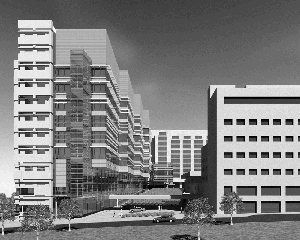|
|
Research Building On Fast TrackFuture JHMI facility to house genetics institute, other biomedicine labs
By Marjorie Centofanti |

Under a large white tent on a sweltering June day, ground was broken for construction on the East Baltimore campus of a 10-story, $140 million research building that's a concrete-and-brick metaphor for today's biomedical science.
The building, housing the McKusick-Nathans Institute for Genetic Medicine, other School of Medicine laboratories and a state-of-the-art mouse facility, becomes part of a recent approximately $324 million investment in research infrastructure on the medical campus. It's slated to open early in 2004.
 |
| Ground was broken on June 12 for a 10-story research building, shown here in an architect's rendering, at North Broadway and Madison Street. To be completed in 2004, the building will house the McKusick-Nathans Institute for Genetic Medicine, other laboratories and a mouse facility. |
The building's early stages, including design approval, have moved with unprecedented speed, reflecting Hopkins' determination to respond quickly as the scientific spotlight shifts to new areas of medical research and the NIH doubles its research budget.
The School of Medicine currently receives more NIH funding than any other medical school. "To maintain this position, we need more space for our brilliant scientists," says Edward D. Miller, dean of the medical faculty and CEO of Johns Hopkins Medicine.
Because many of the changes to come in biomedicine will be driven by current discoveries from the Human Genome Project, the McKusick-Nathans Institute for Genetic Medicine will be a key program. Institute scientists will study genes that trigger disease directly, as well as genes that make people more disease-susceptible. The scientists also will study how genes influence medical treatment.
The institute is named for two Hopkins pioneers in genetics research, Lasker Award-winner Victor McKusick, University Professor of Medical Genetics, and Nobel laureate Daniel Nathans, who died early this year.
The new research labs also will reflect the blurring of scientific boundaries that marks biomedicine, and therefore probably won't be arranged traditionally by department. "We want instead to bring a new cohesion to research by arranging the labs according to scientific problems," says Chi Dang, vice dean for research. For example, labs of biologists studying genes that control embryo development might be clustered with those of researchers whose animal models for Down syndrome overexpress those genes. Researchers exploring how the genes relate to mouse behavior might be in the cluster, as well as biochemists trying to tease out pathways in the brain that the genes activate.
Described by Miller as "the new gateway to the School of Medicine and another step in our continuing effort to revitalize this part of the city," the building will occupy a wedge-shaped lot bordering North Broadway and Madison Street. A spokesperson for Payette Associates of Boston, the architects, cites 380,000 gross square feet as the probable size.
Most important for researchers in the new building, as well as those throughout Hopkins, will be the easy availability of "core facilities"--centers that offer often costly cutting-edge technology or perform highly skilled techniques out of reach for individual labs. The building will house a DNA array center with the ability to tell which genes are expressed in individual cells and help pinpoint disease genes.
Another core facility will allow scientists to follow molecules step-by-step through small animals' biochemical pathways in real time. This facility aims to use molecular tracers and PET scanners with new precision.
A large state-of-the-art "mouse house" in the building will foster the rapid creation of animal models of human disease. A combination of layout and robotics will greatly reduce stressful mouse/human contact under the most hygienic of conditions.
Funding for the new structure includes $23.8 million from the state of Maryland, whose support was recognized throughout the dedication.
In his opening remarks at the June 12 ceremony, Michael Bloomberg, chairman of the university board of trustees, described the new facility in terms of the dominoes that provided a backdrop in the tent. "The story of this building--how it has come about and the research that will be done here--is like [a] chain of dominoes, separate pieces working in synchronous harmony to achieve a whole greater than the sum of its parts," he said. "The pieces--the partners--working together to make this building a reality are the determined leaders of the state of Maryland, generous private philanthropists and this university and its brilliant, dedicated faculty and staff."
President William R. Brody applauded the state's commitment of almost $24 million for the new research building, saying, "That money will help build a state-of-the-art facility that will bring new hope and new treatment to many thousands across the state and around the world.
"It was just one year ago that the governor announced his ambitious plan for the Tobacco Settlement Fund, earmarking a significant portion of the funds to conquer tobacco-related cancers," Brody continued. "As the plan moved through the legislative process, both the governor and the Legislature made it clear that they recognized the critical role academic medical centers will play in this effort, particularly in translating research into the treatments and, we hope, the cures that are so desperately needed."
Among those attending the ceremony were Georges Benjamin, secretary for health and mental hygiene of the state of Maryland; 7th district congressman Elijah Cummings; U.S. Sens. Paul Sarbanes and Barbara Mikulski; Maryland Sen. Nathaniel McFadden; and Maggie McIntosh, state delegate and associate for federal relations in the university's Office of Federal Relations.
| GO TO JUNE 19, 2000 TABLE OF CONTENTS. |
| GO TO THE GAZETTE HOMEPAGE. |